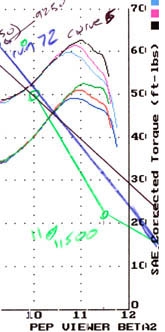The Wolf ignition system is still in use on this engine. It
controls a 3D advance curve by taking RPM and throttle position
inputs. It automatically swaps to a milder advance curve
in 6th gear (reads a gear selection sensor) to stave off
detonation. It controls the water injection system on/off
points and checks switching RPM to throttle position. it has
built-in control for quickshifter operation.
Unfortunately, the TZ requires a very large amount of ignition
advance, more than I can get from the Wolf igntion when the
stock timing mark (on the crank) is used. This winter
we’ll relocate the timing notch to about 45 degrees BTDC
so I can get a full advance curve on the engine. So far I
have been as much as 10 or more degrees behind what a stock TZ
needs for advance. Hopefully this will help to wake the
engine up, next spring. We plan to swap crank wheels from
side-to-side, and cut a new notch in one of the currently
virginal crank wheels.
Thus far, I’ve been using
modified “Darcy pipes” , which were designed around
the OEM RG barrels and at 113mm are much too skinny for TZ
application. They were also too long, and I had to
shorten them considerably. Actually, they’ve been
chopped and modded about 3 times, now. We have a new
pipe spec sorted, which is very similar to a std TZ pipe,
which should also help to wake up the engine next spring.
The plan is to allow the pipes to run up to 11500 or
11750 rpm, and use water injection to fill in the lower part of
the powerband.
Water injection is a big part of
this package. Still controlled by the CDI, it should be
able to reduce peak torque rpms to 9000/ 9500 RPM when
activated. Hopefully we’ll be able to get a very
wide, and high, plateau of torque in the 70 ft-lb range, while
still revving out to 11700 or so. In theory, that ought
to be good for 155 hp.
Frankly, I had no idea what to
expect when I got this thing running. Initially, I had to
deal with crazy low-end carburetion. But, that
didn’t prevent me from riding it. What I found was,
the motor made better power in the 5000-6000 rpm range than my
old RG setup. I attribute this to the excellent
powervalve, which drastically reduces the height of the exhaust
valve to something more suited to a trials bike. It ran
well on top but oddly enough, still peaked at 10300 or so, like
my old motor. None of the screaming, 12,000 rpm power I
had been expecting. Now, I knew my pipes were designed to
peak at 10.2 or so, but I figured that with all this extra
exhaust port height, it would still rev out higher than the old
barrels. No dice. A trip to the dyno revealed
125 HP and 65 ft-lbs, but much less upper-midrange than
my old setup. Damn! Were the pipes so long that
they were beyond some critical threshold, where the ports just
didn’t work like they were supposed to? I cut the
pipes down a few inches. Bingo- 12,000 rpm power-
but was it any faster? Another trip to the dyno.
Still at 125 HP, but now it had to do 11000 rpm to do it.
This time, though, I had overrev to end all overrev.
It would easily do 12k, and even with the powervalves set
in the low rpm position, it revved to the moon. Anyhow,
it was no real improvement.
Next, I cut the pipes a bit more, in the
headpipe, to try and bring the vacuum vace back into synch with
the stuffing pulse. result? 125 hp, but now at
11500 rpm. Shit! Powerband was considerably
narrower than what I had when using the RG barrels.
I rode it like this for the rest of that
year. The next spring, I planned to go to Daytona and
contest the Brute HP shootout at AMI. I had a few mouths
to shut, and I did call out Mr Lance to bring his best bike
down to Daytona and run against me on the dyno in front of
everybody, as he had been investing quite a lot of time and
energy telling people that I had been falsifying my dyno
numbers.
Preparation- Pete bored the carbs
to 36.5mm and I enlarged inlet passages, and advanced timing
another 4 degrees by altering the location of the timing pickup
in the case. Still a good 10 degrees from where it needed
to be. but, it was all I could do. UNFORTUNATELY
(and this is a big one) the shrouds surrounding the main
air bleed entries had been machined off as part of the carb
boring process. I didn’t realize that those babies
HAD to be on there for it to run right. And so...
I ran off to my local dyno guy to test
ignition curves, disc valves, and my next generation pipes.
I also took a can of VP-MR2 oxygenated fuel. I had
to leave for daytona in a few days! What happened was,
the bike would pull on the dyno up to 11,000, then suddenly go
so lean that it would begin barking and backfiring out the
carbs. No matter what I did with jetting, it just would
only run to 11,000 rpm. All the rest of my testing was
rendered moot by this development. I returned home to
try and sort it, and came back day or 2 later.
Shit!! Still ran to 11k and
stopped. It pulled 132 Hp (134 on one jagged run,
but that stuff doesn’t really count) at 11000 with the
power curve climbing sharply, but at 11k it was all over.
After exhaustive tests, I dragged out of there, with
nothing to show for it but new problems. We even tried
the MR2 on the low CR heads, and it hurt power. Damn!
I talked to a few guys, including some
vary sharp tuners, and got suggestions that covered everything
from alien electronics to fuel frothing. I went to
Daytona with car wheel tape weights to stick to my float
bowls..
A few days of struggle in Daytona
revealed no solutions.
The bike just would not run above 11k.
I was even trying to alter the main air bleeds by
epoxying them shut and retapping to a smaller size. I
tried to find air jets: I searched all of Daytona, IN BIKE
WEEK, FOR GOD’S SAKE, and could not find air jets.
I tracked down the Mikuni guy at his giant trailer
outside of Harley Davidson of Daytona. O Mikuni Guy, I
said. I need and assortment of main air jets! And I
listed the sizes. “Nobody’s ever asked me
that before”, he said. And sure enough, he had no
fricking air jets.
I called Darcy in a panic. By this
time, I was considering whether the loss of the main air
bleed shrouds was causing a problem. I had managed to
contact My Favorite Journalist (Kevin Cameron) and he pointed
out that many bikes use controlled airflow across the air bleed
entries to create certain effects at high intake airflows.
Removing the shrouds would certainly have an effect.
Thanks, Kevin! Darcy recommended epoxying aluminum
tubes back into place to shround the entry to the air bleeds.
Voila! it ran perfectly. Too bad I had
completely wasted two trips to the dyno back home. I
slapped it all together and ran off to AMI to run it. My
water injection system was dead because of rust in the steel
lines, so I was running without. The guy asked me where
to gas it, so I said 6500 or something like that. He got
it to 6500 and gassed it.. and it fell right on its face.
Remember that rich hole? Instead of getting off
the throttle, like we would do, he held it open hoping it would
clear out.. but instead, it fouled a plug or 2. I think
it registered 50 hp or something like that. I had to limp
home on 3 cylinders.
I thought boost bottles might help.
I had calculated the volumes and hose lengths for boost
bottles to help with the rich spot, and had already made the
bottles, so I installed them. They actually worked pretty
well, till the gasoline fumes melted the plastic I had
used. Damn!
I decided to fix the crippled water
injection. I spent tuesday night installing new stainless
lines, a new pump, and cleaning out all the fittings and
injectors. I installed the 16:1 heads and filled it with
MR2 fuel. One test ride- it worked like a charm.
No flat spot with that little blue water injector light
winking. And it was faster than holy F%^&. Wed
I was back to AMI bright and early. The top 600 had
posted 103 HP, I believe. We ran my bike up on the dyno
and it ripped, spinning the back wheel on the drum but posting
something like 118 HP. You only get 2 pulls, so that was that.
With the shootout lead, I ran off home. I
rode around all day and decided that the high CR setup was
really no better than my low CR setup. I burned up the
rest of the stinky fuel, which was now enough to make me
sick with one whiff, flushed it out and changed back to Amoco
92. The 102 is too slow-burning for my low CR setup, I
had seen that before when running high octane Swapped on
my 14:1 heads. Went back Thursday and insisted that they
strap the bike down really tightly. It banged out 128.6
Hp on the Superflow, still climbing sharply at 11750 when the
rev limiter kicked in. The correction factor for that day
placed it at 138 dynojet HP- I was pretty happy with the
result, and also with the correlation of my dyno back home,
with the superflow in Daytona. Whatever the absolute
numbers, I beat all the GSXR750s there and was 4 Hp behind the
top R1, which had posted 132 HP. Vindication! ! whew.
An exhausting week. I think I worked as hard as any racer
at the track. Friday I came back to AMI and took the win
with a bye in the 600cc class, at 128.6 HP, as the 103 Hp ZX6R
was not likely to challenge. See the results HERE
Early test of water injection. What
would you pay for a set of pipes that could extend your
powerband like this?
Dialling in the advance curve. Free
HP anyone? Various retard curves Vs Hp output. This
was when I had mysterious 11000 RPM leanout.
Another few runs showing the breakup at
11000 rpm. It was due to machined-off air bleed shrouds.
Look at how fast HP is climbing at 11K. When the
shrouds were fixed, it made 138 Dynojet at 11750 (rev limiter)
and was still climbing sharply. Who knows what it would
have made at 12 or beyond? It revs like a TZ250, after
all.


